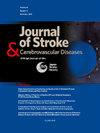Vertebral artery involvement in giant cell arteritis: Symptoms, treatment and outcome
IF 2
4区 医学
Q3 NEUROSCIENCES
Journal of Stroke & Cerebrovascular Diseases
Pub Date : 2025-02-12
DOI:10.1016/j.jstrokecerebrovasdis.2025.108260
引用次数: 0
Abstract
Background
Giant cell arteritis (GCA) of the vertebral artery (VA) is a rare but serious cause of ischemic stroke, however, the long-term clinical and sonographic course of GCA patients with VA involvement (VA+) is poorly understood.
Methods
All patients with suspected GCA who were consecutively referred to our ultrasound (US) lab over a 12-year-period were analyzed. US examination (GCA-specific) of the cranial and cervical arteries was performed. Patients with a positive US diagnosis of GCA were identified, and further analysis was restricted to VA+ patients. Follow-up data were extracted from our hospital database.
Results
Among the 785 patients screened for GCA, 220 showed typical US-based findings for GCA, 74 (34 %) of whom were VA+. Fourteen VA+ patients (19 %) had vertebrobasilar ischemia at presentation (11 stroke, 3 TIA). Cerebral ischemia was more frequent in patients with severe compared to moderate VA occlusive disease (35 % vs 9 %; p = 0.0099, OR = 5.39, 95 % CI 1.50–9.42). Two patients died from severe initial stroke. Follow-up data were available for 34 VA+ patients (46 % of all VA+ patients; median period, 740 days), where 13 (38 %) displayed stable US alterations to the VA, 14 (41 %) a regression and 7 (21 %) a progression of stenosis. Four patients (12 %) had vertebrobasilar re-stroke, 3 of them within 30days of treatment initiation.
Conclusion
One-third-of patients with cranial GCA were VA+, 19 % of whom had vertebrobasilar stroke, of which most had severe VA occlusive disease. Significant rates of stenosis progression and recurrent stroke therefore call for early intensive immunosuppressive treatment.
求助全文
约1分钟内获得全文
求助全文
来源期刊

Journal of Stroke & Cerebrovascular Diseases
Medicine-Surgery
CiteScore
5.00
自引率
4.00%
发文量
583
审稿时长
62 days
期刊介绍:
The Journal of Stroke & Cerebrovascular Diseases publishes original papers on basic and clinical science related to the fields of stroke and cerebrovascular diseases. The Journal also features review articles, controversies, methods and technical notes, selected case reports and other original articles of special nature. Its editorial mission is to focus on prevention and repair of cerebrovascular disease. Clinical papers emphasize medical and surgical aspects of stroke, clinical trials and design, epidemiology, stroke care delivery systems and outcomes, imaging sciences and rehabilitation of stroke. The Journal will be of special interest to specialists involved in caring for patients with cerebrovascular disease, including neurologists, neurosurgeons and cardiologists.
 求助内容:
求助内容: 应助结果提醒方式:
应助结果提醒方式:


